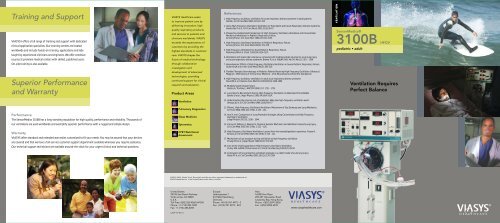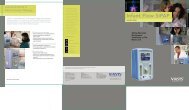Brochure - Zeba Medical
Brochure - Zeba Medical
Brochure - Zeba Medical
Create successful ePaper yourself
Turn your PDF publications into a flip-book with our unique Google optimized e-Paper software.
Training and Support<br />
VIASYS® offers a full range of training and support with dedicated<br />
clinical application specialists. Our training centers are located<br />
worldwide and include hands-on training, applications and labs<br />
taught by experienced clinicians and engineers. We offer extensive<br />
courses at premiere medical centers with skilled, published users.<br />
On-site training is also available.<br />
Superior Performance<br />
and Warranty<br />
Performance<br />
The SensorMedics 3100B has a long-standing reputation for high quality, performance and reliability. Thousands of<br />
our ventilators are used worldwide and exemplify superior performance with a rugged and simple design.<br />
Warranty<br />
VIASYS offers standard and extended warranties customized to fit your needs. You may be assured that your devices<br />
are covered and that we have a full-service customer support department available whenever you require assistance.<br />
Our technical support technicians are available around-the-clock for your urgent clinical and technical questions.<br />
VIASYS Healthcare seeks<br />
to improve patient care by<br />
delivering innovative, high<br />
quality respiratory products<br />
and services to patients and<br />
clinicians worldwide. VIASYS<br />
exceeds the expectations of<br />
customers by providing the<br />
highest standards in customer<br />
care. VIASYS shapes the<br />
future of medical technology<br />
through collaborative<br />
investigation and<br />
development of advanced<br />
technologies, providing<br />
continued support for clinical<br />
research and education.<br />
Product Areas<br />
VIASYS, AVEA, Simple Touch, Bicore Vela and Vela are either registered trademarks or trademarks of<br />
VIASYS Healthcare Inc. in the United States and/or other countries.<br />
United States:<br />
22745 Savi Ranch Parkway<br />
Yorba Linda, CA 92887<br />
U.S.A.<br />
Toll-Free: (800) 520-4368 (HFOV)<br />
Phone: +1 (714) 283-1830<br />
Fax: +1 (714) 283-8493<br />
L2839-101 Rev A<br />
Ventilation<br />
Pulmonary Diagnostics<br />
Sleep Medicine<br />
Spirometry<br />
CPET/Nutritional<br />
Assessment<br />
References<br />
1. High-frequency oscillatory ventilation for acute respiratory distress syndrome in adult patients.<br />
Derdak, S.Crit Care Med 2003;31:S317-323<br />
2. Using High-Frequency Oscillatory Ventilation to Treat Adults with Acute Respiratory Distress Syndrome.<br />
Hynes-Gay P et al. Crit Care Nurse 2001;21(5):38-47.<br />
3. Prospective, Randomized Comparison of High Frequency Oscillatory Ventilation and Conventional<br />
Mechanical Ventilation in Pediatric Respiratory Failure.<br />
Arnold JH et al. Crit Care Med. 1994;22:1530-1539.<br />
4. High Frequency Oscillatory Ventilation in Pediatric Respiratory Failure.<br />
Arnold JH et al. Crit Care Med.1993;21:272-278<br />
5. High Frequency Ventilation for Acute Pediatric Respiratory Failure.<br />
Rosenberg RB et al. Chest. 1993;104:1216-1221.<br />
6. Ventilation with lower tidal volumes as compared with traditional tidal volumes for acute lung injury<br />
and acute respiratory distress syndrome. Brower R, et al. NEJM 2000; Vol 342 No 18; 1301 - 1308<br />
7. Hemodynamic Effects of High Frequency Oscillatory Ventilation in Severe Pediatric Respiratory Failure.<br />
Gutierrez JA et al. Inten Care Med.1995;21:505-510.<br />
8. Flexible Fiberoptic Bronchoscopy in Pediatric Patients Receiving High Frequency Oscillation. (Abstract)<br />
Maggi JC. 1994 Society of Critical Care Medicine - 23rd Educational and Scientific Symposium<br />
9. High-frequency oscillatory ventilation in adult acute respiratory distress syndrome.<br />
David M et al. Intensive Care Med Oct 2003;29(10):1656-1665.<br />
10. Multiple System Organ Failure.<br />
Slutsky A, Trembly L, ARCCM 1998; 157: 1721 - 1725<br />
11. Lung Volume Recruitment During High Frequency Oscillation in Atelectasis Prone Rabbits.<br />
Byford U et al. J Appl Physiol. 1988; 64:1604-1614.<br />
12. Understanding the pressure cost of ventilation: Why does high-frequency ventilation work?<br />
Venegas JG et al. Crit Care Med 1994;22(9):S49-57<br />
13. Pillow J. High Frequency Oscillatory Ventilation: Mechanism of Gas Exchange and Lung Mechanics.<br />
Crit Care Med 2005; Vol 33 No. 3; 135 - 141.<br />
14. Imai Y, et al. Comparison of Lung Protective Strategies Using Conventional and High Frequency<br />
Oscillatory Ventilation.<br />
J Appl Physiol 2001 91; 1836 - 1844.<br />
15. Carney D, DiRocco J, Nieman G. Dymanic Avleolar Mechanics and Ventilator Induced Lung Injury.<br />
Crit Care Med 2005; Vol 33 No. 3; 122 - 128.<br />
16. High Frequency Oscillatory Ventilation: Lessons from the neonatal/pediatric experience. Froese A,<br />
Kinsella J. Crit Care Med 2005; Vol 33 No 3; 115 - 121<br />
17. Mechanisms of gas transport during ventilation by high-frequency oscillation.<br />
Chang HK et al. J App Physiol 1984;56(3): 553-563<br />
18. Care of the Child Supported on High Frequency Oscillatory Ventilation.<br />
Curley MA. AACN Clinical Issues in Critical Care Nursing 1994:5(1):49-58<br />
19. Comparison of lung protective ventilation strategies in a rabbit model of acute lung injury.<br />
Rotta AT et al. Crit Care Med 2001;29(11):2176-2184<br />
Europe:<br />
Leibnizstrasse 7<br />
D-97204 Hoechberg<br />
Germany<br />
Phone: +49 (0) 931 4972 - 0<br />
Fax: +49 (0) 931 4972 - 423<br />
Asia:<br />
1605B Sino Plaza<br />
255-257 Gloucester Road<br />
Causeway Bay, Hong Kong<br />
Phone: +(852) 2891 8026<br />
Fax: +(852) 2893 6939<br />
www.viasyshealthcare.com<br />
V E N T I L AT I O N<br />
SensorMedics®<br />
3100B HFOV<br />
pediatric • adult<br />
Ventilation Requires<br />
Perfect Balance
The True Meaning of Lung<br />
Protective Ventilation<br />
A randomized, controlled trial comparing HFOV and conventional ventilation in an adult patient population with severe<br />
ARDS demonstrated that HFOV is both safe and effective and resulted in a 29% relative reduction in mortality. 1 Ongoing<br />
research will serve to broaden the use of HFOV, while streamlining its application.<br />
FDA Information on<br />
the 3100B<br />
U.S. Food and Drug Administration<br />
CENTER FOR DEVICES AND RADIOLOGICAL HEALTH<br />
Department of<br />
Health and<br />
Human Services<br />
“What will it accomplish? Like all ventilators, this device will breathe for a<br />
patient by delivering oxygen to the patient’s lungs and removing carbon dioxide.<br />
However, this high-frequency ventilator may produce less injury than conventional<br />
ventilators. A clinical study showed better survival for patients treated with the high-<br />
frequency ventilator as compared to those treated with a conventional ventilator.<br />
Also, the high-frequency ventilator patients were more likely to successfully breathe<br />
on their own after six months....”<br />
Exerpt from:<br />
FDA Information on the 3100B<br />
http://www.fda.gov/cdrh/mda/docs/p890057s014.html<br />
The Science Says It All<br />
The SensorMedics 3100B signals the arrival of the next generation of High Frequency Oscillatory Ventilators. Based<br />
on the established technology of the Model 3100A ventilator, the 3100B HFOV adds the enhanced performance<br />
capabilities necessary for adult ventilation and is approved for the treatment of acute respiratory failure in adults<br />
and large children weighing more than 35 kilograms. The 3100B allows the application of continuous distending<br />
pressures up to 55 cmH2O to recruit and normalize lung architecture while ventilating the patient with near<br />
deadspace tidal volumes for the ultimate in low stretch lung protection.<br />
Neutrophils<br />
Biochemical Injury<br />
(Biotrauma)<br />
Bacteria<br />
Cytokines,<br />
complement<br />
PGs, LTs, ROS<br />
Proteases<br />
Distal Organ Dysfunction<br />
Biophysical Injury<br />
• shear<br />
• over distension<br />
• cyclic stretch<br />
• ∆ intrathoracic pressure<br />
alveolar-capillary permeability<br />
cardiac output<br />
organ perfusion<br />
When the lung is damaged by conventional ventilation, it may lead to chronic changes. Other organs may be<br />
compromised by harmful cytokines and proteins released into the bloodstream. 10 The SensorMedics 3100B can<br />
decrease the risk of these complications by maintaining a constant distending pressure and normalizing the end<br />
expiratory lung volume. 14<br />
Unique Technology<br />
Repeated derecruitment<br />
and recruitment of alveoli<br />
= Lung Injury<br />
• SensorMedics 3100B produces an active exhalation. 13 This is essential at high frequency respiratory rates to<br />
prevent air trapping that may occur with high frequency ventilators that utilize passive exhalation.<br />
• Patented technology is distinguished from other<br />
high frequency ventilators by its highly-reliable<br />
electromagnetically driven piston.<br />
• Design permits variable I:E ratios, which are<br />
desirable for managing ventilation.<br />
Pressure<br />
30%<br />
inhalation<br />
exhalation<br />
Time<br />
70%<br />
3100B offers adjustable inspiratory time: 30 - 50%<br />
15<br />
The SensorMedics® 3100 series goes beyond convention. As the gold standard in high frequency oscillatory ventilation,<br />
the SensorMedics 3100B has changed the way clinicians around the world ventilate by setting the benchmark for open<br />
lung, low stretch, lung protective strategies. This unique technology was built upon the understanding that gentle lung<br />
recruitment and optimal ventilation require perfect balance.<br />
3100B ventilates<br />
in this “Safe” Window<br />
Volume<br />
“Safe”<br />
Window<br />
Zone of<br />
Derecruitment<br />
and Atelectasis<br />
Pressure<br />
Froese AB, Crit Care Med 1997; 25:906<br />
Zone of<br />
Overdistention<br />
Ventilation Requires<br />
Perfect Balance<br />
There is no other high frequency device that can<br />
ventilate patients that are over 35 Kgs. According<br />
to the ARDSnet protocol, pediatric and adult<br />
patients with ARDS should be ventilated<br />
with small tidal volumes. 6 The 3100B easily<br />
incorporates this philosophy. Utilizing less than<br />
deadspace tidal volumes, the 3100B makes small<br />
tidal volume management easier to achieve. 16



